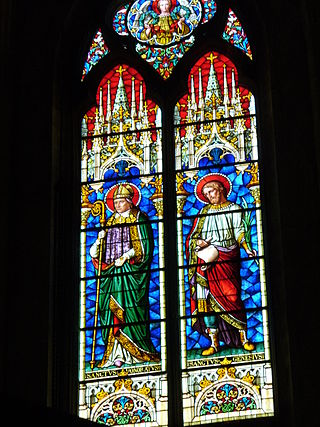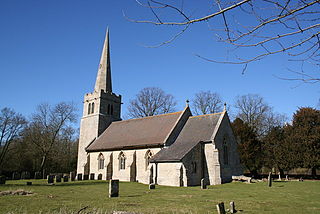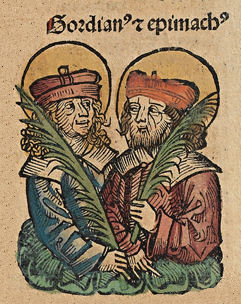Honorius was a member of the Gregorian mission to Christianize the Anglo-Saxons from their native Anglo-Saxon paganism in 597 AD who later became Archbishop of Canterbury. During his archiepiscopate, he consecrated the first native English bishop of Rochester as well as helping the missionary efforts of Felix among the East Anglians. Honorius was the last to die among the Gregorian missionaries.
Saint Wolfeius was a hermit at St Benet Hulme in the English county of Norfolk.
Nothhelm was a medieval Anglo-Saxon Archbishop of Canterbury. A correspondent of both Bede and Boniface, it was Nothhelm who gathered materials from Canterbury for Bede's historical works. After his appointment to the archbishopric in 735, he attended to ecclesiastical matters, including holding church councils. Although later antiquaries felt that Nothhelm was the author of a number of works, later research has shown them to be authored by others. After his death he was considered a saint.
Bregowine was a medieval Archbishop of Canterbury. Little is known of his origins or his activities as archbishop, although a number of stories were told about his possible origins after the Norman conquest in 1066. There are no records of him prior to his becoming archbishop. He possibly owed his elevation to the Kentish monarch. The records after his elevation to Canterbury are mainly about disputes over land, but knowledge of his time in office is hampered by the destruction of many of the contemporary records. After his death, he was considered a saint and a life about him was written in the 12th century.

Saint Genesius of Arles was a notary martyred under Maximianus in 303 or 308. His Feast day is celebrated on August 25. He is honoured as the patron saint of notaries and secretaries, and invoked against chilblains and scurf.

Saint Adalbert of Egmond was a Northumbrian Anglo-Saxon missionary. He was one of Saint Willibrord's companions in preaching the gospel in Holland and Frisia.
Æthelwine was the second bishop of Lindsey from around 680, and is regarded as a saint.
Aldwyn is an Anglo-Saxon saint. The village of Coln St Aldwyn in Gloucestershire is generally supposed to be named after him.
Wilfrid II, name also spelled Wilfrith, also known as Wilfrid the Younger, was the last bishop of York, as the see was converted to an archbishopric during the time of his successor.

Saint Hybald, also known as Higbald, Hibald or Hygbald, was a 7th-century Saxon saint. His feastdays are 18 September and 14 December (Orthodox).

Epimachus of Alexandria was a Roman martyr who died in 250 during the Decian persecution. He and his companions—Alexander, Ammonarion, Mercuria, Dionysia and other women—were beheaded at Alexandria. They are commemorated on 12 December.

Saint Oudoceus (Latin) or Euddogwy (Welsh) is generally known as the third Bishop of Llandaff in South Wales. In reality he was probably a 7th-century bishop at Llandeilo Fawr. Wendy Davies puts his episcopal reign between about 650 and 700.

The coat of arms of Nowy Sącz in Poland shows Saint Margaret the Virgin, depicting the legend that she was swallowed by Satan, in the form of a dragon, who was however forced to spit her out again because the cross she was carrying irritated the dragon's innards. In Margaret's other hand is an olive branch, a symbol of peace.
Ithamar was the first bishop in England to be Saxon-born rather than consecrated by the Irish or from among Augustine's Roman missionaries. He was also the first Saxon bishop of Rochester.

Hugh Candidus was a monk of the Benedictine monastery at Peterborough, who wrote a Medieval Latin account of its history, from its foundation as Medeshamstede in the mid 7th century up to the mid 12th century.

Aidan of Lindisfarne was an Irish monk and missionary credited with converting the Anglo-Saxons to Christianity in Northumbria. He founded a monastic cathedral on the island of Lindisfarne, known as Lindisfarne Priory, served as its first bishop, and travelled ceaselessly throughout the countryside, spreading the gospel to both the Anglo-Saxon nobility and the socially disenfranchised.
Locution is a paranormal phenomenon or supernatural revelation where a religious figure, statue or icon speaks, usually to a saint. Phenomena of locutions are described in the lives of Christian saints such as Saint Mary of Egypt, who heard the locution from the Icon of Virgin Mary at the Holy Sepulchre or in case of the Saint Henry of Coquet Island who experienced the locution from the figure of Christ crucified.

Cwenburh of Wimborne was an 8th-century Anglo-Saxon saint, a sister of King Ine of Wessex and of Saint Cuthburh. Her sister Cuthburh was married to King Aldfrith of Northumbria and then became the first abbess of Wimborne monastery.

Bercthun of Beverley also known as Bertin and Britwin, Berhthu or Beorhthun, was an eighth century Anglo Saxon Saint.
Amandus was the bishop of Bordeaux for two non-consecutive periods between about 404 and 431.










